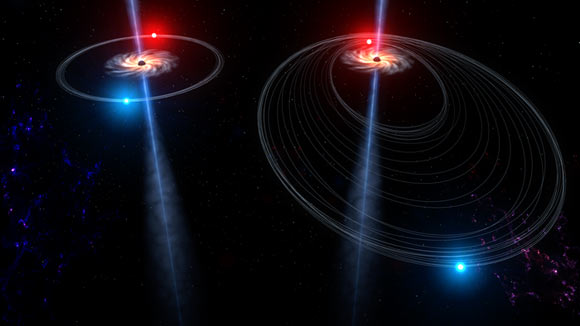The Andromeda galaxy is a barred spiral galaxy 2.5 million light-years from Earth. Otherwise known as Messier 31, it hosts a double nucleus, which is well-explained by a massive disk of apse-aligned stellar orbits about a supermassive black hole, a configuration astronomers call an eccentric nuclear disk. In a new paper published in the Astrophysical Journal Letters, a duo of University of Colorado Boulder astronomers proposes a new formation mechanism for such nuclear disks via the gravitational wave recoil kick of the central black hole.

Graphic showing the orbit of stars around a supermassive black hole before, left, and after, right, a gravitational kick. Image credit: Steven Burrows / JILA.
“When scientists first looked at the Andromeda galaxy, they were expecting to see a supermassive black hole surrounded by a relatively symmetric cluster of stars. Instead, they found this huge, elongated mass,” said Dr. Ann-Marie Madigan, senior author of the paper.
In the new study, Dr. Madigan and her colleague, Tatsuya Akiba, used computer simulations to track what happens when two supermassive black holes go crashing together.
Based on their calculations, the force generated by such a merger could bend and pull the orbits of stars near a galactic center, creating that telltale elongated pattern.
“When galaxies merge, their supermassive black holes are going to come together and eventually become a single black hole. We wanted to know: What are the consequences of that?” Akiba said.
“Mergers may play an important role in shaping these masses of stars. When galaxies collide, the black holes at the centers may begin to spin around each other, moving faster and faster until they eventually slam together.”
“In the process, they release huge pulses of gravitational waves. Those waves will carry momentum away from the remaining black hole, and you get a recoil, like the recoil of a gun.”
The astronomers wanted to know what such a recoil could do to the stars within one parsec (3.3 light-years) of a galaxy’s center.
They used computers to build models of fake galactic centers containing hundreds of stars — –then kicked the central black hole to simulate the recoil from gravitational waves.
“The gravitational waves produced by this kind of disastrous collision won’t affect the stars in a galaxy directly,” Dr. Madigan said.
“But the recoil will throw the remaining supermassive black hole back through space — –at speeds that can reach millions of miles per hour, not bad for a body with a mass millions or billions of times greater than that of Earth’s Sun.”
“If you’re a supermassive black hole, and you start moving at thousands of kilometers per second, you can actually escape the galaxy you’re living in.”
“When black holes don’t escape, however, we discovered they may pull on the orbits of the stars right around them, causing those orbits to stretch out.”
“The result winds up looking a lot like the shape we see at the center of Andromeda.”
_____
Tatsuya Akiba & Ann-Marie Madigan. 2021. On the Formation of an Eccentric Nuclear Disk following the Gravitational Recoil Kick of a Supermassive Black Hole. ApJL 921, L12; doi: 10.3847/2041-8213/ac30d9







